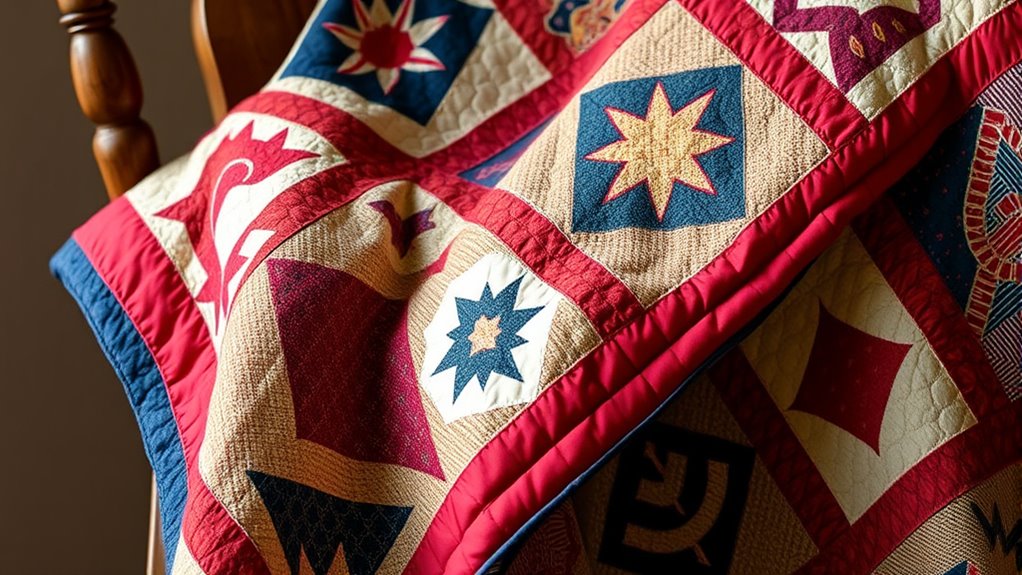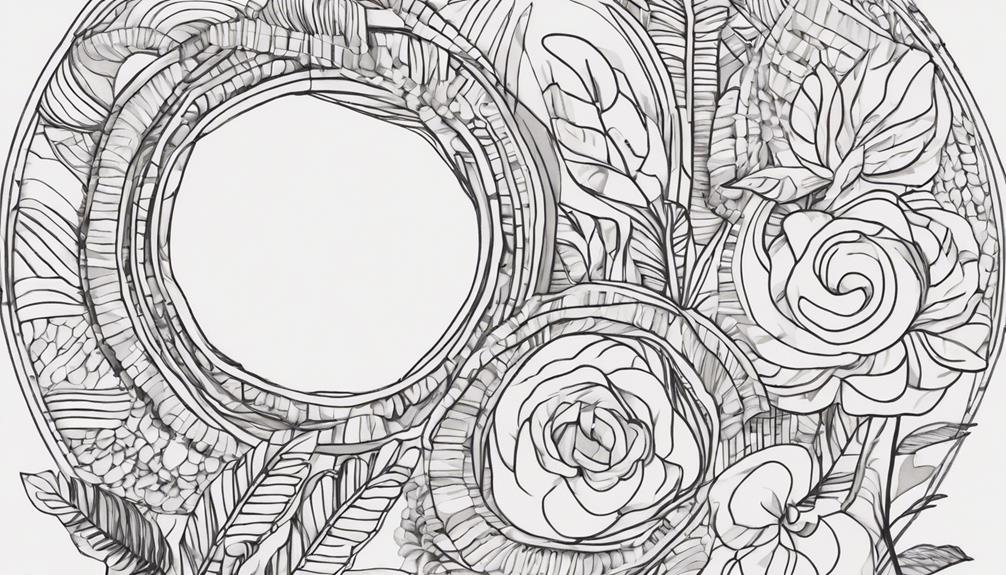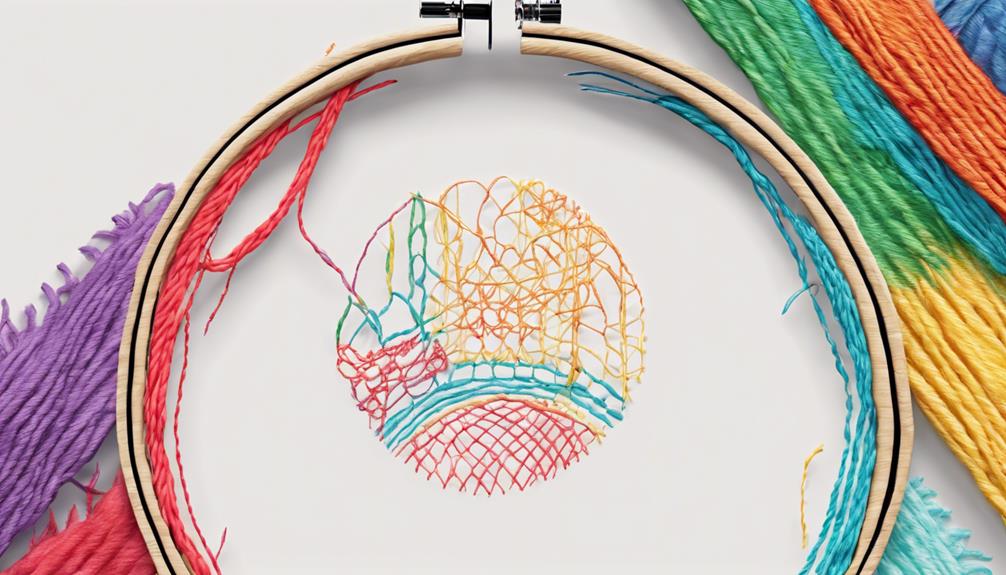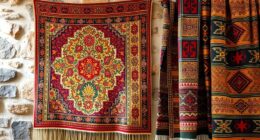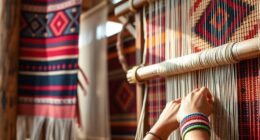Storytelling through quilts involves recognizing how patterns, symbols, and colors encode personal, cultural, or emotional messages. Each quilt acts as a visual story, with designs that highlight memories, traditions, or messages of hope and love. By paying attention to these cues, you can uncover layered meanings woven into each patch. If you keep exploring, you’ll discover how quiltmakers use symbolism and design to communicate more than just warmth, revealing powerful stories hidden within the fabric.
Key Takeaways
- Quilts encode personal, cultural, and historical stories through patterns, colors, and symbols, transforming fabric into visual narratives.
- Embedded motifs like stars or hearts convey messages of hope, love, remembrance, or guidance.
- Narrative techniques such as repetition, contrast, and sequencing guide viewers through the story’s emotional or chronological flow.
- The quilt-making process reflects storytelling, with fabric choices and arrangement symbolizing ideas and memories.
- Recognizing quilt symbolism deepens understanding, connecting viewers to the maker’s intentions and cultural heritage.
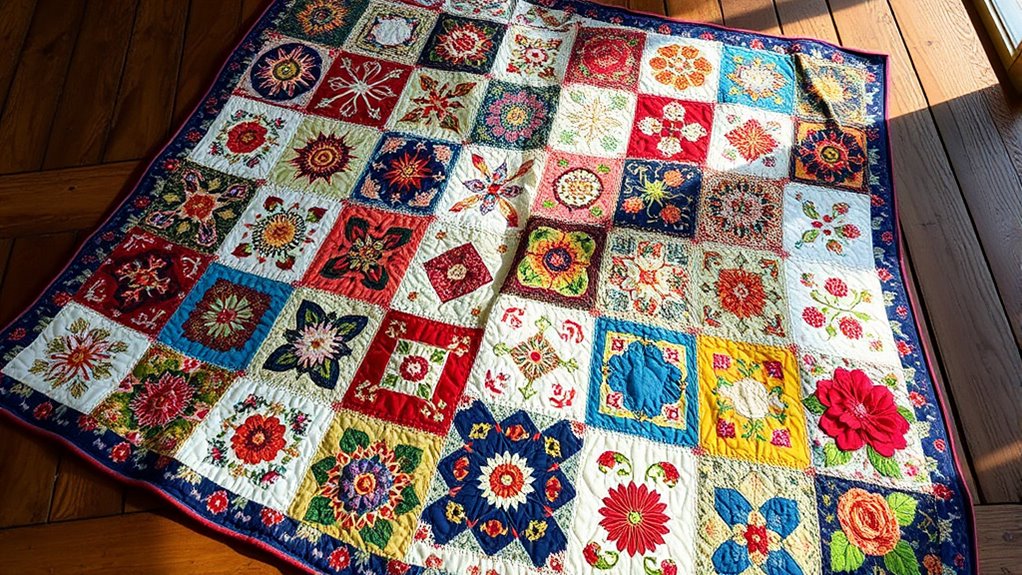
Quilts have long been more than just cozy coverings; they serve as powerful storytelling mediums. When you look closely at a quilt, you’re not just observing a patchwork of fabric but entering a visual narrative filled with symbolism and meaning. Quilt symbolism allows you to decode messages embedded within the fabric, revealing stories about personal history, cultural heritage, or significant life events. Each pattern, color choice, and arrangement acts as a piece of a larger story, often carrying cultural or familial significance. For example, a star pattern might symbolize hope or guidance, while a heart motif could represent love or remembrance. These symbols turn a simple blanket into a narrative device that communicates beyond words, inviting you to interpret the underlying story through visual cues.
Narrative techniques are woven into these quilts in ways that engage you actively. Quilters often use repetition, contrast, and sequencing to tell a story visually. Repetition of specific motifs might emphasize a recurring theme or memory, while contrasting colors highlight pivotal moments or emotional shifts. The arrangement of patches can also follow a chronological order, guiding you through a story from beginning to end. You might notice how certain blocks are placed to evoke a sense of movement or progression, creating a visual journey for the viewer. These techniques allow you to interpret the quilt’s message not just through the images but through the arrangement and design choices made by the quilter. In addition, understanding quilt symbolism can deepen your appreciation of the layered meanings conveyed.
As you examine a quilt, you realize that the act of piecing it together mirrors storytelling itself. The process of selecting fabrics, arranging patches, and sewing them into a cohesive whole mirrors the way stories are crafted—by choosing meaningful elements and organizing them to evoke emotion or understanding. Quilt symbolism and narrative techniques work hand-in-hand to communicate complex ideas without words. You’re encouraged to look beyond the surface, to read between the lines and interpret the stories encoded in every stitch. Whether it’s a family heirloom recounting generations or a community quilt capturing shared history, each piece acts as a visual narrative that invites your interpretation.
Ultimately, understanding quilt symbolism and narrative techniques enriches your appreciation of these textiles. They transform a simple patchwork into a layered story, a visual language that speaks directly to your senses and emotions. When you recognize the symbols and techniques embedded in a quilt, you become part of the story, connecting with the maker’s intentions and the history woven into every stitch. It’s this ability to convey complex stories through fabric that makes quilts enduring symbols of personal and cultural expression.
Frequently Asked Questions
How Do Different Cultures Influence Quilt Storytelling Techniques?
You see, different cultures influence quilt storytelling techniques through rich cultural symbolism and unique narrative motifs. When you explore quilts from diverse backgrounds, you notice how symbols represent beliefs, history, or social status. These motifs serve as visual language, conveying stories and traditions. By understanding these cultural elements, you gain deeper insight into the quilt’s meaning, appreciating how each culture’s storytelling methods weave their identity into every patch.
What Materials Are Best for Preserving Quilt Stories Long-Term?
When choosing materials for preserving quilt stories long-term, you should prioritize fabrics with high durability, like cotton or linen, which withstand aging better. Use preservation techniques such as acid-free backing and proper storage in a cool, dry environment to prevent deterioration. Avoid synthetic fabrics that may degrade faster. By selecting durable fabrics and employing careful preservation methods, you guarantee your quilt’s storytelling remains intact for generations to come.
Can Modern Technology Enhance Traditional Quilt Storytelling Methods?
You can definitely enhance traditional quilt storytelling with modern technology. Digital integration allows you to add multimedia elements like audio and video to quilts, enriching their narratives. Virtual exhibitions give you a platform to showcase your quilts worldwide, reaching a broader audience. By blending old-world craftsmanship with new tech, you make stories more immersive and accessible, preserving their significance while engaging future generations in meaningful ways.
How Do Quilt Stories Impact Community Identity and Cohesion?
You see, quilt stories serve as powerful tools for strengthening community identity and cohesion. By sharing personal histories through patchwork, you create a sense of belonging and collective memory. These quilts become a form of community celebration, reflecting diverse experiences and fostering connections. When you participate in quilt-making or display these stories, you help preserve cultural traditions and build a united, proud community that values its shared heritage.
What Training or Skills Are Needed to Interpret Quilt Narratives Effectively?
Ever wondered what secrets lie within a quilt’s intricate patterns? To interpret quilt narratives effectively, you need a keen understanding of quilt symbolism and narrative interpretation. You’ll develop skills in visual analysis, cultural history, and storytelling techniques. With practice, you’ll uncover hidden messages and deepen your appreciation of the quilt’s story. This knowledge transforms a simple patchwork into a powerful vessel of history, emotion, and cultural identity.
Conclusion
As you wrap yourself in a quilt, each patch whispers stories of love, history, and hope. The vibrant colors and intricate stitches become a tapestry of memories, inviting you to feel the hands that crafted it. With every fold, you’re touching a hidden language, a silent dialogue of life’s journeys. In this comforting quilt, you find not just warmth, but a rich narrative woven with passion and history, waiting to be uncovered anew.

